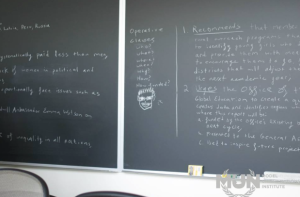
Preambular Clauses: What are we trying to solve and why?
When delegates spend hours upon hours trying to solve a major problem of the world, numerous subtopics will be discussed. For example, the topic of “women’s rights” can lead into discussions on education, labor rights, food security, employment, and many more subtopics that relate to this broad topic. However, the ultimate goal is to create and pass resolutions in committee to be applied to the world and solve the issue at hand. Therefore, when presenting draft resolutions, preambular clauses are very important to remind delegates of what the committee is trying to solve, why we are trying to solve it, and the past actions that have already been taken regarding the topic.
Preambular clauses, generally shortened as preambles, help explain the basis of action that will be introduced and requested for in the operative clauses, which present the actual solutions delegates propose. They are used to build arguments on what sub issue needs most focus, or can build support on having other delegates agree with the group’s focus. Preambles do not have to take up much room in the actual draft resolution. They should be concise, and generally delegates have about 5-7 preambular clauses after their heading and before their operative clauses.
Preambles can refer to the UN Charter, but if doing this, this preamble should be written first before any other preambles. If the resolution refers to the UN Charter’s “purposes and principles” to put emphasis on the importance of the topic, there should be a more specific preamble listing a specific Article of Chapter related to the topic. And also don’t forget- the first time you mention the Charter, it should listed as the “Charter of the United Nations,” but just the “Charter” afterwards is fine.
After mentioning the Charter, you can refer to past resolutions or decisions related to the topic. For example, you can write “Recalling its resolution 65/309 of 19 July 2011,” when referring to a past resolution written. Make sure to write “Recalling Security Council resolution…” if the resolution was adopted in Security Council, to be precise. The first time you mention a Security Council resolution, the date must be included. However, after that, only the resolution number and year is sufficient, such as “resolution 338 (1973)” only.
In your preambles, make sure to include general observations on the purpose and content of the resolution to make a basis for the operative clauses. You can list specific focuses the resolution will take place on, such as education and jobs, so delegates listening will know what to look out for.
And lastly, it is formal to include a reference to a report as your last preamble. For example, you would write “Taking note of the report of the Secretary-General.” You would also include the actual text of the report as a reference as a footnote for other delegates to reference, and to show your group was fully prepared and researched!
Operative Clauses: The MEAT to your Resolution
The ultimate goal for your committee is to create and pass resolutions that can and would be enforced to help solve the problems at hand. When drafting resolutions, formalizing committee solutions is done with operative clauses. There are many parts to a resolution, but operative clauses are undoubtedly the most important section as they have the details for the solutions proposed by the committee.
Operative clauses will vary from conference to conference. In some cases, a single operative clause can be as short as a sentence, in others it can be longer than two pages. While having a lot of information and clauses are important for draft resolutions, quality and substance is the most important aspect when it comes to your operative clauses. Although preambular phrases are significant to an extent, most time presenting draft resolutions will be spent on discussing operative clauses. Therefore, delegates should focus most of their time writing and perfecting operative clauses as much as possible in the limited time they have.
Operative clauses should be detailed and concise. Although it might be hard to do both, delegates should understand that just having 20 operative clauses versus one with 5 clauses does not make the longer resolution better. Make these clauses have the details to show the solutions have been fully researched, but being more concise makes it more clear, and being more clear makes it easier for other delegates to understand and ask questions on, as well as support your resolution.
To have your operative clauses emphasize the solution, refer to the past. You can make references to the Charter or previous resolutions related to the topic. You should also specify current actions that the committee will be taking. For example, using words such as “Decides,” “Decides also,” and “Decides further” are some verbs to show the committee is committing to these solutions. Words such as “Requests” can be used when asking the Secretary-General to do something.
When a General Assembly resolution is asking of something from the Security Council, wording should be very policy and formal, using verbs such as “Recommends” or “invites” rather than forceful or aggressive tones. Different words to start a clause can also provide different senses of urgency of emotion. For example, “Urges” would be stronger than words such as “Calls upon” or “Requests.” The word with the highest level of emotion generally used, but also rarely used outside of the Security Council, is “Demands.”


